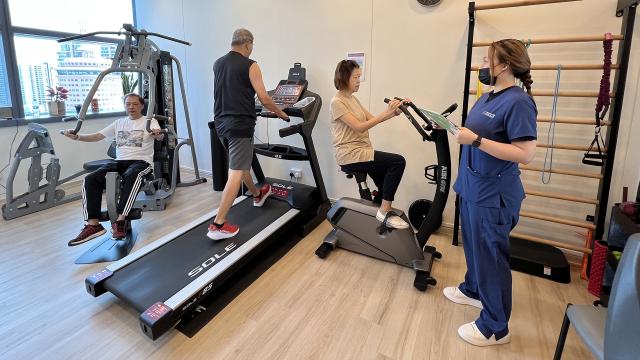
27 October 2020 – Regular physical activity is known to improve physical and psychosocial outcomes after stroke [1]. Yet, across the world, stroke survivors engage in very low levels of physical activity. Based on a survey by students from Singapore Institute of Technology (SIT), the situation in Singapore is no different. The study has shown that factors hindering stroke survivors from being active extend beyond a lack of motivation.
Led by Associate Professor Kwah Li Khim, Health and Social Sciences, SIT, and Dr Shamala Thilarajah, Principal Physiotherapist at Singapore General Hospital (SGH), a team of students reading the Bachelor of Science with Honours in Physiotherapy programme studied the barriers to physical activity faced by 38 stroke survivors from the Singapore National Stroke Association (SNSA), from June 2019 to December 2019. The top three barriers are: a lack of suitable exercise classes/programmes for stroke survivors at fitness centres, lack of assistance from fitness centre staff, and feelings of tiredness/fatigue. There are other significant factors such as a lack of appropriate exercise equipment at fitness centres, high membership fees, motivation loss, concerns about injuries and/or pain that prevent stroke survivors from being active.
Multi-pronged approach required to encourage physical activity among stroke survivors
“Stroke survivors in Singapore walk an average of 5,382 steps a day [2]. This is less than the recommended 6,500 to 8,500 steps a day for people with disabilities or chronic illnesses [3], and far from the recommended 10,000 steps a day for the healthy population [4]. Physical inactivity is a complex problem that goes beyond the individual. Other than feeling too tired to exercise, lack of motivation, fear of injury and pain, we now know that there are many more barriers stopping stroke survivors from being physically active. These are factors that organisations and the public can help with to make the environment more conducive for stroke survivors to be active,” said A/Prof Kwah.
A/Prof Kwah and Dr Thilarajah will be collaborating with Sportcares - ActiveSG, SNSA, and Republic Polytechnic to introduce MOTIVATE: a multi-modal training programme to promote physical activity after as stroke. The programme will include education and training resources for stroke survivors, caregivers, healthcare and fitness professionals on topics like health screening prior to exercise, selection and modification of exercises using gym equipment and adaptive aids such as arm and leg straps. The MOTIVATE programme, which is due for completion at the end of 2022, will also work on establishing a pathway to improve access and use of fitness centres for stroke survivors in Singapore.
“After a stroke, survivors’ ability to perform activities of daily living may be impaired to varying degrees. Inactivity and reduced fitness have many consequences beyond increased risk of stroke. With the MOTIVATE programme, we hope to improve stroke survivors’ access to fitness centres. This is a step towards an inclusive society where stroke survivors have the same access and opportunities to physical activity as the rest of Singapore’s healthy population,” said Dr Thilarajah.
According to the Singapore Stroke Registry published recently, the number of stroke episodes had increased by more than 40 per cent in a decade – from 5,760 episodes in 2009 to 8,326 episodes in 2018. Most strokes are preventable through a healthy diet, regular exercise of at least 150 minutes [5] every week or take 10,000 steps a day, and avoid smoking and drinking too much alcohol.
---
References:
- [1] van Wijck F, Bernhardt J, Billinger SA, et al. Improving life after stroke needs global efforts to implement evidence-based physical activity pathways. International Journal of Stroke. Apr 11 2019:1747493019840930.
- [2] Thilarajah S, Bower KJ, Hao PY, et al. Modifiable factors associated with poststroke physical activity at discharge from rehabilitation: Prospective cohort study. Physical Therapy. Jan 29 2020.
- [3] Tudor-Locke C, Craig CL, Aoyagi Y, et al. How many steps/day are enough? For older adults and special populations. International Journal of Behavioral Nutrition and Physical Activity. Jul 28 2011;8:80
- [4] Tudor-Locke C, Craig CL, Brown WJ, et al. How many steps/day are enough? For adults. International Journal of Behavioral Nutrition and Physical Activity Jul 28 2011;8:79.
- [5] Aim for 150 Minutes of Physical Activity Every Week. Ministry of Health; 2020. https://www.healthhub.sg/live-healthy/386/150minutes
![[FA] SIT One SITizen Alumni Initiative_Web banner_1244px x 688px.jpg](/sites/default/files/2024-12/%5BFA%5D%20%20SIT%20One%20SITizen%20Alumni%20Initiative_Web%20banner_1244px%20x%20688px.jpg)


